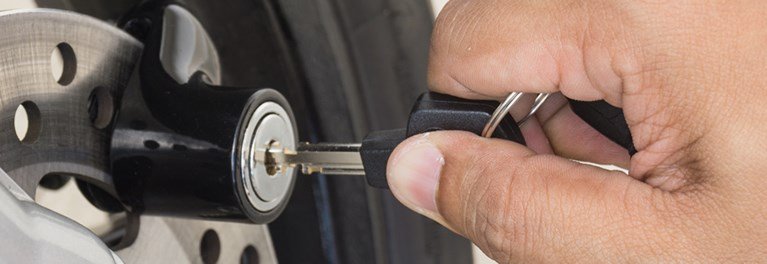Bike security
A high percentage of motorbike claims are due to theft, and it’s common for bikes to be stolen straight from the owner’s home. If you want to ensure your bike remains where you left it, security is something you should take seriously…
Although most bikes come fitted with a steering lock that prevents the handlebars from being turned, it’s a good idea to take additional security measures whenever you leave your bike unattended.
Fortunately, there are all sorts of devices that will help make your bike as secure as possible. Most will fall into one of the following categories:
1. Factory-fit security devices
Factory-fit security devices are built into a bike at manufacturing stage, giving it an extra degree of security before it even hits the showroom.
Manufacturers are encouraged to fit these devices to help reduce the number of theft claims connected to their bikes – after all, no-one wants to buy a bike with the reputation of being the most stolen.
Primarily, these devices take the form of immobilisers that are built into a bike's ignition to ensure that it can only be started by an original manufacturer-supplied key. Thanks to the chip technology used, a potential thief's makeshift key would be useless.
Some examples of this type of security are:
- K.I.S.S (Kawasaki Ignition Security System)
- SAIS (Suzuki Advanced Immobilisation System)
Many stolen bikes are broken down for parts, so security markings are a way of deterring thieves, as they know a marked bike will be more difficult to sell on.
2. Security markings
Many stolen bikes are broken down for parts, so security markings are a way of deterring thieves, as they know a marked bike will be more difficult to sell on.
Mark your bike in as many places as possible with identifying details, such as your postcode or your VIN (vehicle identification number). This can easily be done with a UV pen, or, alternatively, you can use of the numerous kits available.
These kits often come with at least one distinctive sticker which you should place on a prominent part of the bike to show that your bike is ‘marked’.
Popular examples of security markings kits are:
- Datatag
- Alphadot
- Smartwater
3. Alarms and immobilisers
A Category One alarm/immobiliser is a device that’s been approved by an independent security firm, typically Thatcham, which means that some insurers will offer you a discount if your bike is fitted with one. This ensures that your bike can’t be started, and the alarm will sound if your bike is tampered with.
These devices are great at preventing theft, as the alarm can sound if the bike is moved, the wires are cut, or even if the bike is gently knocked. They also have their own built-in power supply, so if the wire to the bike's battery is cut, they will still operate under their own power.
Insurers like these types of devices as they are 'self-arming', which means they are not reliant on you remembering to activate the device. Once you switch your bike off, the device will arm itself a few seconds later. When you need to start your bike, you just need to press a button on a fob (often kept with your bike key), which deactivates the device.
Some examples of Category One alarm and immobilisers are:
- Datatool System Four C1 Red
- Meta M357TV2
- Spyball 6829

4. Physical security
From padlocks and chains to disc locks and ground anchors, these security devices will physically prevent your bike from being moved.
Fixing a chain to your bike's wheel will stop someone from wheeling your bike away, but to make it even more secure it's advisable to attach the chain to an immovable object like a lamppost, metal railing or ground anchor. This will then prevent your bike from being picked up and put in the back of a van.
It's worth considering the placement of a chain, too. Keeping it off the ground will prevent someone trying to sever it against the hard surface, while avoiding any slack will also make it more difficult to snap.
The most secure bikes use a combination of security: a factory-fit immobiliser, security markings, a Category One alarm/immobiliser and some physical security.